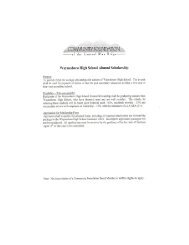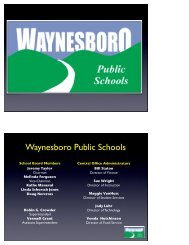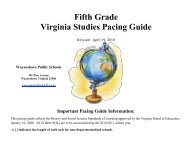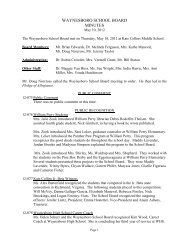Second Grade Reading Pacing Guide - Waynesboro Public Schools
Second Grade Reading Pacing Guide - Waynesboro Public Schools
Second Grade Reading Pacing Guide - Waynesboro Public Schools
You also want an ePaper? Increase the reach of your titles
YUMPU automatically turns print PDFs into web optimized ePapers that Google loves.
through an understanding of<br />
homophones, prefixes, suffixes,<br />
synonyms, and antonyms.<br />
• Students will also develop vocabulary<br />
by discussing meanings of words and<br />
by listening and reading a variety of<br />
text across the content areas.<br />
2.9 The student will read and demonstrate comprehension of nonfiction texts.<br />
b) Make and confirm predictions about the main idea.<br />
e) Ask and answer questions about what is read.<br />
f) Locate information to answer questions.<br />
g) Identify the main idea.<br />
UNDERSTANDING THE STANDARD<br />
(Background Information for<br />
Instructor Use Only)<br />
• Common graphic organizers include:<br />
• ° Venn diagram;<br />
° cause and effect;<br />
° sequencing;<br />
° compare and contrast; and<br />
° cycle.<br />
• Students will also begin to learn the<br />
skills of summarizing and skimming<br />
to locate specific information in<br />
nonfiction text.<br />
• The main idea is the most important<br />
idea from the paragraph or story.<br />
them read unfamiliar words. meaning of compound words (e.g.,<br />
birdhouse, lighthouse, notebook).<br />
ESSENTIAL UNDERSTANDINGS<br />
All students should:<br />
• demonstrate comprehension of<br />
nonfiction.<br />
• understand that comprehension<br />
requires making, confirming and<br />
revising predictions.<br />
• understand that they must attend to the<br />
details of the text in order to<br />
comprehend.<br />
ESSENTIAL KNOWLEDGE AND SKILLS<br />
To be successful with this standard,<br />
students are expected to:<br />
• begin to skim text for information to<br />
answer specific questions<br />
• ask and answer questions about what<br />
is read to demonstrate understanding<br />
(e.g., who, what, when, where, why,<br />
and how)<br />
• use text features to locate<br />
information and answer questions<br />
(e.g., illustrations and captions,<br />
heading and subheadings, bold and<br />
italic print, tables of contents,<br />
glossaries, charts, tables).<br />
• determine the main idea.<br />
• organize information, using graphic<br />
organizers.<br />
• use knowledge of sequence to make<br />
48









